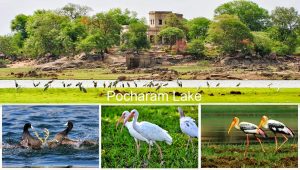Wild Life and Ecotourism of Telangana
Introduction:
Telangana is a state in the Southern region of India. It has an area of 1,12,077 sq.kms., after the Andhra Pradesh Reorganization (amendment) Act, 2014 (as per Act No. 6of 2014 it was 1,14,840 kms.), and is the twelfth largest state in terms of both areaand the size of the population in the country. Most of it was part of the princely stateof Hyderabad, ruled by Nizam of Hyderabad during the British Raj, joining the Union ofIndia in 1948. In 1956, the Hyderabad state was dissolved as part of the linguisticreorganization of states, and the Telugu speaking part of Hyderabad state, known asTelangana, was merged with former Andhra State to form Andhra Pradesh. On 2nd June 2014,Telangana was separated from Andhra Pradesh as a new 29th state of India, with thecity of Hyderabad as its capital.
The state is bordered by the states of Maharashtra, Chattisgarh to theNorth, Karnataka to the west, and Andhra Pradesh to the south, east and north east.The major cities in Telangana state include Hyderabad, Warangal, Mahabubnagar,Karimnagar, Nizamabad, and Khammam. The State is strategically located in the Deccan plateau in a semi-arid region. The climate is predominantly hot and dry.
Wild Life and Ecotourism of Telangana
Telangana has rich forests and wild life sanctuaries, which provide scope for eco-tou rism and wildlife tourism that cover Alisagar Deer park in Nizamabad, the Eturunagaram Sanctuary and Pakhal Wildlife Sanctuary in Warangal, Kawal Wildlife Sanctuary, Jannaram, Pranahitha Wildlife Sanctuary and Sivaram Wildlife Sanctuary in Adilabad, Mahavir Harina Vanasthali National Park, Vansthalipuram and Nehru Zoological park in Hyderabad, Manjira Bird Sanctuary inSangareddy, and Pocharam Sanctuary in Medak, Shamirpet Deer Park in Rangareddy.
rism and wildlife tourism that cover Alisagar Deer park in Nizamabad, the Eturunagaram Sanctuary and Pakhal Wildlife Sanctuary in Warangal, Kawal Wildlife Sanctuary, Jannaram, Pranahitha Wildlife Sanctuary and Sivaram Wildlife Sanctuary in Adilabad, Mahavir Harina Vanasthali National Park, Vansthalipuram and Nehru Zoological park in Hyderabad, Manjira Bird Sanctuary inSangareddy, and Pocharam Sanctuary in Medak, Shamirpet Deer Park in Rangareddy.
Tourism
The tourism in the present day, has become increasingly significant and organized (industry) as moreand more people with increased disposable income, higher propensity to spend and changing socialmores trot cities and countries due to variety of reasons. Along with the evolution of tourism, its definitionhas also formalized over the years and in the present parlance a visitor is considered to be a traveller taking a trip to a main destination outside their usual environment, for less than a year, for any mainpurpose (business, leisure or other personal purpose) other than to be employed by a resident entityin the country or place visited A visitor (domestic, inbound or outbound) is classified as a tourist (orovernight visitor), if his/her trip includes an overnight stay, or as a same-day visitor (orexcursionist) otherwise. A traveler on the other hand is someone who moves between differentgeographic locations, for any purpose and any duration. The visitor is a particular type of traveller andconsequently tourism is a subset of travel. However, “Tourism” refers to all activities of visitors, includingboth “tourists (over-night visitors)” and “same-day visitors”.In the context of Telangana, its culture combines cultural customs from Persian traditionsembedded during Moghuls, QutubShahis and Nizams rule with prominent and predominantlysouth Indian traditions and customs. The State has a rich tradition in classical music. It has a richpainting and folk arts such as Burrakatha, shadow puppet show, and Perini Shiva Tandavam, GusadiDance, Kolatam etc. Telangana has a variety of tourist attractions including historical places,monuments, forts, waterfalls, forests and temples. Lakhs of tourists, including foreign tourists visitthese tourist attractions every year and carrying their experiences, customs and traditions of Indianheritage, sweet memories to their native states or countries
Rural Tourism
Telangana has a tremendous potential for Rural Tourism and is a fascinating canvas of myriadcolors, cultures and customs. Handicrafts represent, perhaps, the oldest traditions of living culture andTelangana has some of the richest sources of handicrafts
Heritage Tourism
Telangana is a historic land dotted with a number of forts, which have a potential to be developedinto classic heritage tourism sites. Some famous forts, where Tourism Department is taking up projectsto develop amenities for tourists are Golconda Fort, Medak Fort, Khammam Fort, Nizamabad Fort,Elagandula Fort, Karimnagar and Bhongir Fort, Nalgonda. Warangal Fort and Golconda Fort also hostSound and Light shows which take us back to a magnificient past. More shows of this kind willhighlight the rich heritage of Telangana. Telangana State Tourism Development Corporation (TSTDC)organizes all the above tourist packages and also connects the neighboring States. TSTDC alsomaintains Haritha Hotel chains, wayside amenities, river cruises and water fleet in different locations. Anytrip to Telangana State is incomplete without a taste of its cuisine, including the famous HyderabadiBiryani, Qubani-ka-Meetha, Haleem,Osmania Biscuits and Irani Chai.
Key sectoral issues and concerns:
- Habitat loss and degradation, caused by logging for firewood and timber materials, are major threats to restricted-range species
- Poaching , hunting and unsustainable exploitation threaten both flora and fauna
- Tourism transportation and usage of high carbon intensive fuels in resort/tourist spots cause high levels of Carbon di oxide emissions which increasethe pollution levels in tourist places like Warangal and Hyderabad etc
Interventionsand Strategies:
- Promote lowemission/fuel-efficient mass transportation, to and within tourist areas (e.g. battery operated vans operating around the TajMahal)
- Promote energyefficiency lighting, climate control equipment in hotels and other areas where tourists congregate
- Promote eco-tourism to enhance environmental consciousness
- Enforce cleanliness in tourist areas
- Protect both built and natural heritage against climate related damage (e.g. damage from high temperature, water accumulation, pests etc.)